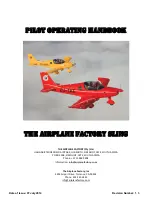
THRUSH AIRCRAFT, INC – MODEL S2R-R1340
AIRCRAFT MAINTENANCE MANUAL
8-8
Effective: 01/01/08
FUEL PRESSURE SYSTEM.
The fuel pressure gauge, like the oil
pressure gauge, operates off of the
Bourdon Tube principle, so that the
system does not require any electricity.
Instead, fuel is piped to the gauge from
the left side of the carburetor float bowl,
which is downstream of the engine
driven fuel pump.
Low fuel pressure in the carburetor
could lead to engine fuel starvation and
subsequent unplanned shut-down. Low
fuel pressure can be caused by a bad
engine driven fuel pump, a clogged filter
screen somewhere in the fuel supply
system, or empty fuel tanks.
If the fuel tanks are not empty, then
turning on the auxiliary fuel pump could
keep the engine running long enough to
make a precautionary landing. It is not
a good practice to leave the aux fuel
pump running continuously, however.
MANIFOLD PRESSURE SYSTEM
The manifold pressure gauge indicates
the pressure of the fuel/air mixture in the
intake manifold, downstream of the
supercharger. This indicator uses a
bellows type mechanism, however, as
they respond better to gas pressure
better than a Bourdon Tube does. The
manifold pressure system nonetheless
does not need electrical power to
operate.
The manifold pressure gauge is
connected to the engine intake manifold
by tubing and hoses, and because of
the compressibility of the intake gases
the indication lags behind engine
pressure by a fraction of a second.
More than a second’s lag indicates a
problem with the indicating system.
If the manifold pressure system is
working normally, it is an indicator of the
power output of the engine. The old
caution of increasing engine RPM prior
to increasing manifold pressure is still a
good practice, as high power applied to
a high pitch propeller increases the
strain on the engine without necessarily
giving the thrust desired.
A decrease in manifold pressure during
normal engine operation should first
suggest carburetor icing, and prompt the
pilot to apply carburetor heat. Power
will return to normal shortly if icing was
the cause. If power does not return to
normal, the air filtration system may be
clogged, or the engine may have a
mechanical problem.
Note that when the engine is not
running, the manifold pressure gauge
indicates field barometric pressure.
TACHOMETER SYSTEM
The tachometer system is electronic,
and therefore functions only when
supplied with electrical power by the
airplane. The system has a signal
generator mounted on the engine’s
tachometer drive which supplies digital
information to the indicator. The
tachometer indicator interprets this
digital information and displays it with a
needle and scale. The indicator has an
integral hour meter built in, so that
engine time is accumulating any time
the engine is running.
The tachometer indicates the RPM the
engine is turning the propeller at, which
must be kept within a specified range.
An over-speed condition would
generally indicate a prop governor or
prop blade mechanism failure. An
inability to produce desired RPM when
the engine is putting out adequate
power would indicate a propeller pitch
mechanism problem.








































